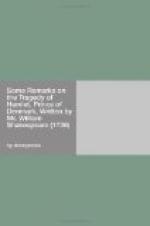ACT V.
The Scene of the Grave-Diggers. (p. 344.) I know is much applauded, but in my humble Opinion, is very unbecoming such a Piece as this, and is only pardonable as it gives Rise to Hamlet’s fine moral Reflections upon the Infirmity of human Nature.
Page 354.
Hamlet’s Return to Denmark is not ill contriv’d; but I cannot think that his Stratagem is natural or easy, by which he brings that Destruction upon the Heads of his Enemies, which was to have fallen upon himself. It was possible, but not very probable; because methinks, their Commission was kept in a very negligent Manner, to be thus got from them without their knowing it. Their Punishment was just, because they had devoted themselves to the Service of the Usurper in whatever he should command, as appears in several Passages.
It does not appear whether Ophelia’s Madness was chiefly for her Father’s Death, or for the Loss of Hamlet. It is not often that young Women run mad for the Loss of their Fathers. It is more natural to suppose, that like Chimene in the Cid, her great Sorrow proceeded from her Father’s being kill’d by the Man she lov’d, and thereby making it indecent for her ever to marry him.
Page 351.
In Hamlet’s leaping into Ophelia’s Grave, (which is express’d with great Energy and Force of Passion) we have the first real Proof of his Love for her, which during this whole Piece has been forced to submit to Passions of greater Weight and Force, and here is suffered to break out chiefly, as it is necessary towards the Winding up of the Piece. It is but an Under-Passion in the Play, and seems to be introduced more to conform to the Plan our Poet built upon, than for any Thing else; tho’ as the whole Play is managed, it conduces towards the Conclusion, as well as it diversifies, and adds Beauties to the whole Piece.
Page 357.
The Scene of the Fop Osrick is certainly intended as a Satire upon the young Courtiers of those Days, and is humourously express’d, but is, I think, improper for Tragedy.
Hamlet’s feeling, as it were, a Presage in his own Breast, of the Misfortune impending from his accepting Laertes’s Challenge, is beautiful; and we are to note, that our Author in several of his Plays, has brought in the chief Personages as having a sort of prophetick Idea of their Death; as in Romeo and Juliet. It was (I doubt not) the Opinion of the Age he lived in.
Laertes’s Death, and the Queen’s, are truly poetical Justice, and very naturally brought about; although I do not conceive it to be so easy to change Rapiers in a Scuffle, without knowing it at the Time.
The Death of the Queen is particularly according to the strictest Rules of Justice, for she loses her Life by the Villany of the very Person, who had been the Cause of all her Crimes.




